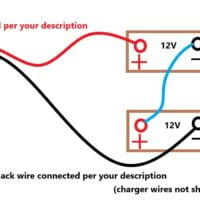My current Boat has a 24 volt trolling motor. I have a onboard charger hooked to each of the two trolling motor Batteries. Several issues going on. First of all I think the onboard charger is going bad. It has 2 sets of charging lights. The lights for the Left side battery are not lighting and I assume that battery is not being charged. I have no idea how the charge from each battery is used to run the trolling motor. Does it pull a equal amount of charge from each battery> I also think my Batteries are going bad and am going to probably replace both of them soon. ( I think they are 4-5 Years old ) From looking at the connections it looks like there is a Pos. and a Neg. wire coming direct from the trolling motor. The pos. is going to the pos. on 1 battery and the Neg. is going to the Neg. on the other Battery. It looks line there are two wires coming from the onboard charger. Each containing a Pos. and Neg. wire. One going to each battery. Even when the onboard charger was working one battery always seemed to take much longer to charge. I just assumed that most likely more power from that battery was being used when I ran the trolling motor. I am currently using the onboard charger to charge the right side battery and then hooking a manual charger to the Left side battery to charge that. When I am charging the left side battery with the manual charger, I assume that no charger is being carried over to the right side battery correct? I know lots of questions. I have little to none electrical knowledge as you can tell. My plan is to replace both batteries hooking up everything the same way as it is now. I want to see if the onboard battery charger is still only showing one set of lights after I do so. If so I may have to also replace the onboard charger as well or keep charging both of them Separate. One with the onboard charger and the other with a manual. I’m thinking it would not be good to charge both of them at the same time. Then again I may be wrong and it may be fine to do so. I just want to make sure before replacing the batteries that all my electrical hookups are correct the way they are now. Sorry for all the questions. like I said I have almost Zero electrical knowledge. To be honest, I fear working with anything electric. After seeing two people killer from it, and being zapped a few times in my younger days, I have a fear of it.
IDO » Forums » Fishing Forums » General Discussion Forum » A little help with a 24 Volt Trolling motor setup
A little help with a 24 Volt Trolling motor setup
-
 tswoboda
Posts: 9721July 7, 2023 at 11:42 am #2212438
tswoboda
Posts: 9721July 7, 2023 at 11:42 am #2212438Just my opinion… Buy a 24v 50ah LiFePO4 battery with matching onboard charger for $800 and forget about trolling batteries for the next 10 years.
July 7, 2023 at 11:50 am #2212442Check the fuse on the one side bank that’s not working. Make sure wire connections are clean and clear of corrosion. I just went through the same thing and finally figured out I lost a bank on my charger. I ended up getting a mew noco 2 bank charger for my birthday the other day so my issues are over. But I went through the same headache. I wasn’t sure if it was a battery or charger or both. But check the fuses and make sure both banks are functioning properly. If not you probably lost a bank.
July 7, 2023 at 11:57 am #2212444If your batteries are that old replace them. I have seen corrosion in the fuse connections on the onboard charger that will cause the wire to break which would make the charger think the battery is charged. The connection you mentioned are correct for that setup. The best way to find out if your battery charger is working is to buy a simple volt meter and set it to DC voltage. Check the voltage on the batteries and then plug the charger in. You should see the voltage on the battery increase. Also your resting voltage on those batteries should be 12.6-12.8 if the are fully charged. As far as how does the amperage get drawn from the batteries is going to try to pull the same amperage from each battery but if one is bad it will draw more from one battery. This is why you always replace all batteries in a series connection( the way your batteries are connected). Good Luck
July 7, 2023 at 11:58 am #2212446Just my opinion… Buy a 24v 50ah LiFePO4 battery with matching onboard charger for $800 and forget about trolling batteries for the next 10 years.
If I was planning on keeping this boat for awhile I’d possibly go that route, but I’m probably going to be replacing it soon with a newer one.
July 7, 2023 at 12:12 pm #2212447If your batteries are that old replace them. I have seen corrosion in the fuse connections on the onboard charger that will cause the wire to break which would make the charger think the battery is charged. The connection you mentioned are correct for that setup. The best way to find out if your battery charger is working is to buy a simple volt meter and set it to DC voltage. Check the voltage on the batteries and then plug the charger in. You should see the voltage on the battery increase. Also your resting voltage on those batteries should be 12.6-12.8 if the are fully charged. As far as how does the amperage get drawn from the batteries is going to try to pull the same amperage from each battery but if one is bad it will draw more from one battery. This is why you always replace all batteries in a series connection( the way your batteries are connected). Good Luck
Thanks for the excellent Info. My Volt meter broke when I went to replace the 9 volt battery awhile back and I have not purchased a new one. Now may be a great time to do so. Think I will stop on my way home from work and pickup a new one. I don’t think there is any inline fuse associated with the onboard charger, at least none that I can see. When I first had the problem with the online charger I cleaned up the terminal and all connections and wiggled the wires around. It seemed to work as the charger went back to working correct for a charge or two and then the lights on the one side went back out again. By the looks of the onboard charger – It looks to be really old. I’ve had the boat 5+ years and its a 2001, so no telling how old it may be. PITA to replace the batteries, I did so shortly after I purchased the boat. Had to remove the mounted onboard charger to get the batteries out, No easy task because of how and where its located in the batter area. Then after getting the new Batteries in it was a real pain to get the onboard charger back in place. Not looking forward to doing that again.
July 7, 2023 at 12:17 pm #2212448If your batteries are that old replace them. I have seen corrosion in the fuse connections on the onboard charger that will cause the wire to break which would make the charger think the battery is charged. The connection you mentioned are correct for that setup. The best way to find out if your battery charger is working is to buy a simple volt meter and set it to DC voltage. Check the voltage on the batteries and then plug the charger in. You should see the voltage on the battery increase. Also your resting voltage on those batteries should be 12.6-12.8 if the are fully charged. As far as how does the amperage get drawn from the batteries is going to try to pull the same amperage from each battery but if one is bad it will draw more from one battery. This is why you always replace all batteries in a series connection( the way your batteries are connected). Good Luck
Supercat – one more question. Would I be ok if I charged the battery that the onboard charger seems to be charging while at the same time hooking a manual charger to the other battery. Or should I charge the one with the onboard charger first and disconnect that charger and then charge the other battery with the manual one?
July 7, 2023 at 12:20 pm #2212450I don’t think there is any inline fuse associated with the onboard charger, at least none that I can see.
There should be a fuse between the charger and the battery. One fuse for each bank of the charger.
 isu22andy
Posts: 2141July 7, 2023 at 1:21 pm #2212470
isu22andy
Posts: 2141July 7, 2023 at 1:21 pm #2212470Fighting the same issues- my trolling motor doesnt have the power it used too. Ive load tested all the batteries at Oreilleys, Ive checked the plug and its at 39 volts . Its most likely the batteries but makes a guy wonder.
July 7, 2023 at 1:48 pm #2212472<div class=”d4p-bbt-quote-title”>fishthumper wrote:</div>
I don’t think there is any inline fuse associated with the onboard charger, at least none that I can see.There should be a fuse between the charger and the battery. One fuse for each bank of the charger.
I’ll check again when I get home. I don’t recall one there. There was one there. I thought that one was between the trolling motor and the battery.
July 7, 2023 at 2:58 pm #2212494Fighting the same issues- my trolling motor doesnt have the power it used too. Ive load tested all the batteries at Oreilleys, Ive checked the plug and its at 39 volts . Its most likely the batteries but makes a guy wonder.
I wouldn’t have deep cycle batteries tested and oreillys. Some of their testers aren’t setup to handle deep cycles. Experienced that at a couple places.
Not sure where you are located but I take mine to the local interstate store. They have the tools and knowledge to test the batteries and they will also understand your use case with a trolling motor.
July 7, 2023 at 3:16 pm #2212506<div class=”d4p-bbt-quote-title”>tswoboda wrote:</div>
Just my opinion… Buy a 24v 50ah LiFePO4 battery with matching onboard charger for $800 and forget about trolling batteries for the next 10 years.If I was planning on keeping this boat for awhile I’d possibly go that route, but I’m probably going to be replacing it soon with a newer one.
I’d probably be inclined to go this route if you found out that charger was bad. Being that the batteries are 4-5 years old already, you’re gonna have to replace those anyways.
Once you figure out if the charger is good or bad, then make the decision on whether to upgrade to a lithium battery and charger. I’ve replaced my batteries in the past 2 seasons now but my chargers were still perfectly fine so I simply bought new standard batteries. Most chargers are not compatible with a lithium battery. They’ll work with a lead acid or an AGM.
 klang
Posts: 178July 8, 2023 at 7:14 am #2212546
klang
Posts: 178July 8, 2023 at 7:14 am #2212546Switch the charger wires on your battery. If the one side is still out you know its your charger.
 keith christianson
Posts: 30July 8, 2023 at 8:18 am #2212551
keith christianson
Posts: 30July 8, 2023 at 8:18 am #2212551First thing I would do is have your batteries load tested. It’s possible the one battery is bad. Your trolling motor and chargers sound like they are wired correctly. My thoughts are if one battery is bad it may not take a charge and the on board charger wont charge because it’s dead or bad?
July 8, 2023 at 8:41 am #2212552Fishthumper,
After reading your initial comments, I don’t see you mentioning a “Jumper” cable which would connect the other positive to the other negative battery. I’m no pro on electronics either, however this is how I convert mine to a 24V system.
Did I miss that in your initial description?
This would explain to me why one of the batteries takes so much longer to charge than the other because your basically just running a 12 v system. Do your batteries (or battery which It might only be running off of one) seem to die or drain down rather quickly when running the TM?
This may not solve all of your problems but might be a good start.
July 8, 2023 at 12:32 pm #2212569Fishthumper,
After reading your initial comments, I don’t see you mentioning a “Jumper” cable which would connect the other positive to the other negative battery. I’m no pro on electronics either, however this is how I convert mine to a 24V system.
Did I miss that in your initial description?
This would explain to me why one of the batteries takes so much longer to charge than the other because your basically just running a 12 v system. Do your batteries (or battery which It might only be running off of one) seem to die or drain down rather quickly when running the TM?
This may not solve all of your problems but might be a good start.
I don’t think there is a jumper wire. I know is some 24 volt setups that is used.once again I may be wrong. I’m going to just replace both batteries. When I do so I’m going to label all the wires real well. I’ll have a much better idea of what wires there are there. With 2 new trolling motor batteries hooked up I should be able to determine in the onboard charger is going bad or not.
July 8, 2023 at 1:44 pm #2212572From looking at the connections it looks like there is a Pos. and a Neg. wire coming direct from the trolling motor. The pos. is going to the pos. on 1 battery and the Neg. is going to the Neg. on the other Battery.
I don’t think there is a jumper wire.
Based on the previous info you provided, there HAS to be a jumper wire for the motor to run at all.
July 8, 2023 at 6:05 pm #2212576I read about halfway through this just like the other guys and saw no mention of the jumper. Is there no jumper going between your batteries? Did you figure that out? If there’s not you found your problem
July 8, 2023 at 6:29 pm #2212578I am going to tackle this issue tomorrow. If there needs to be a jumper wire for it to work, there must be one because the trolling motor works fine
July 8, 2023 at 7:35 pm #2212584that jumper wire keeps the batteries in series and you def have that if the motor works. sounds like a bad battery but anything is possible? sometimes you can smell a battery if it goes bad especially if it’s enclosed somewhere. always replace batteries together too
 Onthewater
Posts: 273July 9, 2023 at 8:24 am #2212604
Onthewater
Posts: 273July 9, 2023 at 8:24 am #2212604They made trolling motor plugs that did the jumping to 24 volts in the plug. Since you don’t have a jumper and it’s an older boat that’s what I would guess you have going
July 9, 2023 at 9:09 am #2212611<div class=”d4p-bbt-quote-title”>supercat wrote:</div>
If your batteries are that old replace them. I have seen corrosion in the fuse connections on the onboard charger that will cause the wire to break which would make the charger think the battery is charged. The connection you mentioned are correct for that setup. The best way to find out if your battery charger is working is to buy a simple volt meter and set it to DC voltage. Check the voltage on the batteries and then plug the charger in. You should see the voltage on the battery increase. Also your resting voltage on those batteries should be 12.6-12.8 if the are fully charged. As far as how does the amperage get drawn from the batteries is going to try to pull the same amperage from each battery but if one is bad it will draw more from one battery. This is why you always replace all batteries in a series connection( the way your batteries are connected). Good LuckSupercat – one more question. Would I be ok if I charged the battery that the onboard charger seems to be charging while at the same time hooking a manual charger to the other battery. Or should I charge the one with the onboard charger first and disconnect that charger and then charge the other battery with the manual one?
Yes you can charge both at the same time. When batteries are hooked in series by one wire electrically to the charger it looks like a stand alone battery.
 CaptainMusky
Posts: 25396July 9, 2023 at 9:46 am #2212612
CaptainMusky
Posts: 25396July 9, 2023 at 9:46 am #2212612Just my opinion… Buy a 24v 50ah LiFePO4 battery with matching onboard charger for $800 and forget about trolling batteries for the next 10 years.
You can buy an awful lot of crummy old tech batteries for that but yeah they are nice.
 CaptainMusky
Posts: 25396July 9, 2023 at 9:48 am #2212613
CaptainMusky
Posts: 25396July 9, 2023 at 9:48 am #2212613Agreeing with huntindave. I have a feeling your charger is hooked up and one bank is charging both batteries. Check the charger connections as to where they go. Each bank should charge one battery.
July 9, 2023 at 9:57 am #2212615Crazy turn in the issue. I was going to go buy a multimeter this morning but saw my neighbor who’s an electrician outside and borrowed one from him. Got all set to check the batteries and onboard charger. Started by checking the voltage on each battery. Plugged in the onboard charger to recheck the voltage to see if the charger was working and guess what? The lights that had not been displaying on the left side bank now light up like normal. I confirmed that the onboard charger is now indeed charging both batteries. Now I’m just waiting the left battery to be fully charged so I can test the voltage. The right battery that was fully charged reads 13.0 volts. Now I’m not sure if I need to replace them. Guess I’ll have to see what the other batty reads when fully charged. Interesting thing. I decided to also check my cranking battery while I had the multimeter. That one only showed 12.0 volts. Got that one on the manual charger now. Going to check it again once fully charged. The sticker code for that one says 07/21. So it’s probably just over 2 years old. I’ve always put the charger on it after every few outings. It has always seemed to take a rather long time to charge. I always charge that
One at 2.0 amps so didn’t really think much of it. Now I’m a little worried about that one. If I end up replacing it I’m going to install a power cut off on it. I really think something is pulling power from that battery while not in use. Even after being charged and letting it sit for a few days, if I hooked the battery charger back up to it it would take awhile to show fully charged again. Then again it may be because the battery was not good from the start and just was not holding a good charge. I think the power shutoff switch is a good idea anyway. The cranking battery has never had a problem starting the motor and it’s a 150 or any issues running electronics of live wells so I never gave it any thought that it may be bad or going bad. CaptainMusky
Posts: 25396July 9, 2023 at 11:18 am #2212620
CaptainMusky
Posts: 25396July 9, 2023 at 11:18 am #2212620FYI if you have a jumper from positive of one battery to negative of the other to properly check voltage you will need to disconnect the negative on the one end then test each battery. With it connected touch neg on one battery and pos on other for total voltage. Should be 25.2 plus for a full charge. Good luck buddy!
July 9, 2023 at 11:20 am #2212621Easy way to check if something is drawing power on your starting battery while not in use, take the same meter you bowered from your neighbor and use amps feature and un hook the positive post and insert the meter in series and see what if any current is being used.
July 9, 2023 at 11:49 am #2212622They made trolling motor plugs that did the jumping to 24 volts in the plug. Since you don’t have a jumper and it’s an older boat that’s what I would guess you have going
Based on the information provided in the original post, your “guess” is wrong.
July 9, 2023 at 1:18 pm #2212623FYI if you have a jumper from positive of one battery to negative of the other to properly check voltage you will need to disconnect the negative on the one end then test each battery. With it connected touch neg on one battery and pos on other for total voltage. Should be 25.2 plus for a full charge. Good luck buddy!
You can test the individual batteries without disconnecting the jumper. Just like the charger can charge the individual batteries without disconnecting any wires.
 tswoboda
Posts: 9721July 9, 2023 at 2:35 pm #2212627
tswoboda
Posts: 9721July 9, 2023 at 2:35 pm #2212627Crazy turn in the issue. I was going to go buy a multimeter this morning but saw my neighbor who’s an electrician
Honestly I think the best solution here involves your electrician neighbor and a case of beer…
You must be logged in to reply to this topic.
